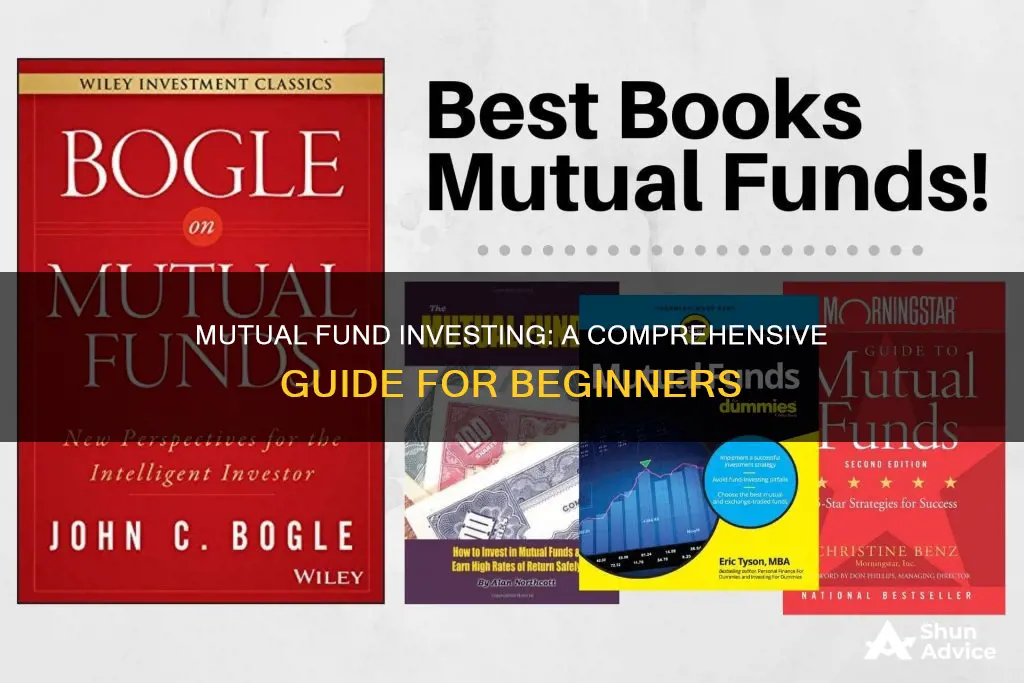
Whether you're a seasoned investor or just starting, books about mutual funds can provide valuable insights and practical advice to help you make informed decisions and achieve your financial goals. The Mutual Funds Book: How to Invest in Mutual Funds and Earn High Rates of Returns Safely by Alan Northcott is one such example. Northcott's book covers the basics of mutual fund investing, including the different types of funds, fees, and management issues. It also provides strategies for expanding your investments and offers a step-by-step guide to help you bring in a steady income while avoiding losses.
Another great resource is Common Sense on Mutual Funds: New Imperatives for the Intelligent Investor by John C. Bogle, the father of index funds. This classic book has been updated to help investors understand mutual funds and how Bogle's simple and low-cost investing strategy can outperform stock pickers. It covers the timeless principles of investing and explores regulatory and structural changes within the global mutual funds industry.
The Mutual Fund Industry by R. Glenn Hubbard offers a critical analysis of the rapidly growing industry, examining the impact of mutual fund governance on fund performance. It also provides an overview of the regulatory history and key legal decisions regarding mutual fund fees.
For those specifically interested in the Indian mutual fund industry, Indian Mutual Funds Handbook 5th Edition: A Guide for Industry Professionals and Intelligent Investors by Sundar Sankaran is a great choice. It compares mutual funds with other investment avenues and guides you on choosing the right funds based on your risk tolerance and financial goals.
These books provide a strong foundation for anyone looking to navigate the world of mutual funds and make informed investment decisions.
What You'll Learn

Mutual fund basics
Mutual funds are a type of investment vehicle that allows investors to pool their money together to purchase a collection of assets, such as stocks, bonds, or other securities. By investing in mutual funds, individuals can diversify their investments and access a wider range of investment opportunities than they might be able to on their own.
Mutual funds are managed by professional fund managers who use investors' money to buy a variety of assets. These assets are held in a portfolio, and the fund manager will make decisions about buying and selling to try and achieve the fund's investment objectives. The value of a mutual fund is determined by the performance of the underlying assets in the portfolio.
Types of Mutual Funds
There are several types of mutual funds, including open-end funds, closed-end funds, exchange-traded funds (ETFs), index funds, bond funds, and money market funds. Each type of fund has its own unique characteristics and risks, so it's important to understand the differences before investing.
Advantages of Mutual Funds
One of the main advantages of mutual funds is diversification. By pooling your money with other investors, you can invest in a wider variety of assets, reducing the risk associated with investing in a single asset or a small number of assets. Mutual funds also offer professional management, as the fund managers are typically experts in the field who can make informed investment decisions on behalf of the fund's investors.
Disadvantages of Mutual Funds
While mutual funds can provide potential high returns, there are also risks involved. The value of mutual funds can fluctuate with the market, and there is no guarantee that you will make a profit. Additionally, mutual funds often come with fees and expenses that can eat into your investment returns. It's important to carefully consider the risks and potential drawbacks before investing.
Choosing a Mutual Fund
When choosing a mutual fund, it's important to consider your investment goals and risk tolerance. Different types of mutual funds carry different levels of risk, so you should select a fund that aligns with your comfort level and financial objectives. It's also crucial to research the fund's performance history, fees, and management team to ensure it meets your expectations.
Crowdfunded Real Estate: Your Guide to Investing Wisely
You may want to see also

Active vs passive funds
The biggest difference between active and passive investing is that active investing involves a fund manager picking and choosing investments, whereas passive investing tracks an existing group of investments called an index. Passive investing strategies tend to perform better and are more cost-effective than active strategies.
Understanding Active and Passive Investing
Active investors research and follow companies closely, buying and selling stocks based on their view of the future. This approach requires a hands-on, short-term mindset that aims to beat the market's average returns. It involves a deeper analysis and expertise to know when to pivot into or out of a particular stock, bond, or asset.
Passive investors, on the other hand, buy a basket of stocks and buy or sell regularly, regardless of market conditions. This approach requires a long-term mindset that disregards the market's daily fluctuations. Passive investors tend to rely on fund managers to ensure the investments held in the funds are performing and expect them to replace declining holdings.
Advantages and Disadvantages of Active Investing
Active investing offers flexibility, allowing managers to buy any investment that meets their criteria. It also enables hedging and risk management strategies, such as short sales or put options, and the ability to exit specific stocks or sectors when risks become too high. Additionally, active investing facilitates tax management strategies tailored to individual investors.
However, active investing is very expensive due to the extensive research, analysis, and transaction costs involved. It carries active and management risks, as fund managers can make costly mistakes, and it may trigger a capital gains tax.
Advantages and Disadvantages of Passive Investing
Passive investing offers ultra-low fees since there is no need to pay for stock picking or extensive analysis. It provides good transparency, as investors always know which assets are in the index fund, and it is tax-efficient due to its buy-and-hold strategy.
However, passive investing is considered too limited by proponents of active investing, as investors are locked into specific holdings regardless of market changes. It may result in small returns, as passive funds rarely beat the market, and investors rely on fund managers for decision-making.
Passive investing tends to deliver better overall returns and is a quicker and easier strategy to implement. It is also more cost-effective due to lower expense ratios.
Despite the efforts of active fund managers, the majority underperform the market benchmark they aim to beat. Even when active funds experience outperformance, it usually doesn't last long. As a result, many individual investors opt for passive investment funds, and passive funds continue to dominate the market.
However, for passive investing to work, investors must remain invested and resist the urge to buy and sell based on market fluctuations.
In conclusion, while both active and passive investing have their advantages, passive investing in passive funds appears to be the winning strategy for most investors.
Cash Funds: A Guide to Investing Wisely
You may want to see also

Mutual fund fees
Annual Fund Operating Expenses
Annual fund operating expenses are ongoing fees that cover the cost of paying managers, accountants, legal fees, marketing, and other administrative costs. These fees are typically between 0.25% and 1% of your investment in the fund per year. Actively managed funds, which aim to beat average stock market returns, tend to have higher annual fund operating expenses than passively managed funds such as index funds, which mirror the returns of a benchmark stock index.
Annual fund operating expenses include:
- Management fees: The cost of paying fund managers and investment advisors.
- 12b-1 fees: Fees capped at 1% that cover the cost of marketing, selling the fund, and shareholder services.
- Other expenses: Custodial, legal, accounting, transfer agent expenses, and other administrative costs.
Shareholder Fees
Shareholder fees are sales commissions and other one-time costs incurred when buying or selling mutual fund shares. These include:
- Sales loads: Commissions paid when buying or selling mutual fund shares, either at the time of purchase ("front-end load") or at the time of sale ("back-end load").
- Redemption fee: A fee charged by some funds if you sell your shares within a short period of purchasing them.
- Exchange fee: A fee charged by some funds if you transfer your shares to another fund within the same fund group.
- Account fee: A fee charged for maintaining your account, often applied if your balance falls below a specified minimum investment amount.
- Purchase fee: A fee paid at the time of purchasing shares, distinct from a front-end sales load.
It is important to note that even if a mutual fund does not charge sales loads, it may still charge redemption, exchange, account, and purchase fees. Additionally, brokers may charge transaction fees for buying or selling mutual funds, typically ranging from $10 to $75.
When considering mutual fund fees, remember that funds with high costs must perform better than low-cost funds to generate the same returns. Even small differences in fees can significantly impact your investment returns over time. Therefore, it is crucial to understand the various fees associated with mutual funds to make informed investment decisions.
A Guide to Investing in Funding Societies
You may want to see also

How to choose a fund
When it comes to choosing a mutual fund, there are several factors to consider. Here are some key steps to help you make an informed decision:
- Identify your investment goals: Determine whether you are investing for the short-term or long-term. If you have a short-term goal, such as building an emergency fund or saving for a vacation, you may want to consider other investment options besides stock and bond mutual funds due to their volatile nature. For long-term goals, such as retirement or buying a house, mutual funds can be a suitable choice.
- Decide on your account type: Choose the type of account that aligns with your investment goals. You can open a standard brokerage account, utilise a 401(k) retirement account offered by your employer, or explore options like traditional or Roth IRAs for tax-advantaged retirement savings.
- Determine your asset allocation: Decide on the right mix of stocks, bonds, and other holdings for your portfolio. This will depend on your investment goals, time horizon, and risk tolerance. If you are starting early, a stock-heavy allocation is generally recommended, while those closer to retirement may want to include more bonds in their portfolio.
- Choose an investment strategy: Decide whether you want to actively pick market-beating stocks or aim for returns that match the market. Active funds employ fund managers who actively research and select investments, while passive funds aim to mirror market benchmarks like the S&P 500. Passive funds tend to have lower fees and often outperform active funds despite their lower costs.
- Research mutual fund companies: Familiarise yourself with reputable mutual fund companies, such as Vanguard, Fidelity, and American Funds. Consider factors like company reputation, regulatory issues, and the types of funds they offer. You may also want to open an investment account directly with a fund company if you find one that aligns with your goals and preferences.
- Evaluate fees and performance: When researching specific mutual funds, pay close attention to their fees and historical performance. Look for funds with competitive expense ratios, as high fees can eat into your returns over time. Additionally, consider the fund's performance over a long period and during different market environments to get a more comprehensive understanding of its success.
- Consider your risk tolerance: Different mutual funds carry varying levels of risk. Assess your own risk tolerance and choose funds that align with your comfort level. Remember that higher-risk funds may offer the potential for higher returns but also come with a greater possibility of loss.
- Diversify your investments: Diversification is a key aspect of successful investing. Opt for mutual funds that invest in a diverse range of companies and sectors to minimise the impact of any single investment on your portfolio's overall performance. This helps protect your investments during market downturns or individual company failures.
- Review fund objectives: Understand the fund's stated objectives, such as the types of shares or bonds they invest in and their risk tolerance. Ensure that the fund's objectives align with your own investment goals and risk appetite.
- Compare similar funds: When deciding between similar funds, use fund screeners and research tools to compare their fees, performance, and holdings. This will help you make a more informed decision about which fund best suits your needs.
Investing in 1confirmation: Strategies for Crypto Venture Capital
You may want to see also

Mutual fund portfolio management
A mutual fund is a type of investment vehicle that allows you to invest in a variety of different assets, such as stocks, bonds, and other securities. By pooling your money with other investors, mutual funds allow you to diversify your portfolio and reduce the risk of individual investments.
There are several benefits to investing in mutual funds:
- Diversification: Mutual funds allow you to diversify your investments across a wide range of assets, reducing the risk of losing money.
- Professional Management: Mutual funds are managed by professional fund managers who have the expertise and resources to make informed investment decisions.
- Affordability: Mutual funds have a low minimum investment requirement, making them accessible to a wide range of investors.
- Convenience: Investing in mutual funds is a convenient way to build a well-diversified portfolio without having to research and choose individual stocks or bonds.
Choosing a Mutual Fund
When selecting a mutual fund, it is important to consider the following factors:
- Financial Goals: Ensure that the fund aligns with your financial objectives, whether they are long-term goals like retirement or short-term goals like saving for a down payment on a car.
- Risk Appetite: Evaluate your risk tolerance and choose funds that match your comfort level. Some funds may be more aggressive and carry more risk, while others may be more conservative.
- Time Horizon: Consider your investment timeframe. If you are investing for the long term, you may be able to withstand more volatility in the market. If you have a shorter time horizon, you may want to choose more stable investments.
Types of Mutual Funds
There are several types of mutual funds to choose from:
- Equity Funds: These funds primarily invest in stocks and can provide higher returns over the long term. They are usually suitable for investors with a higher risk appetite.
- Debt Funds: Debt funds invest in fixed-income securities such as bonds and government securities. They are typically less risky than equity funds and are suitable for short-term goals.
- Large-Cap, Mid-Cap, and Small-Cap Funds: These funds invest in companies based on their market capitalisation. Large-cap funds focus on well-established companies, while small-cap and mid-cap funds invest in smaller or newer companies, which may carry more risk but also offer higher potential returns.
- Sector-Specific Funds: These funds invest in specific industries or sectors, such as technology or healthcare. They can provide specialised exposure to an area of the market that you believe will perform well.
Diversifying Your Portfolio
To build a well-diversified mutual fund portfolio, consider the following tips:
- Asset Allocation: Determine the right mix of equity and debt funds based on your risk tolerance and financial goals. The "100 minus age rule" suggests that you subtract your age from 100 to determine the percentage of your portfolio that should be allocated to equities.
- Number of Funds: Investing in 4-5 different funds within each asset class can help further diversify your portfolio and mitigate risks.
- Regular Review: Periodically review the performance of your mutual funds to ensure they are meeting your expectations. Compare their performance against relevant benchmarks and consider both long-term and short-term returns.
When to Buy and Sell Mutual Funds
Timing your entry and exit in the market can be tricky, and it is generally recommended to take a long-term approach:
- Buying Mutual Funds: Consider investing at regular intervals through a systematic investment plan (SIP). This averages out the cost of your purchases and reduces the impact of market volatility.
- Selling Mutual Funds: Avoid making impulsive decisions during market downturns. Instead, focus on your long-term objectives and hold on to your investments unless you need the money for other financial goals.
Recommended Reading
To learn more about mutual fund portfolio management and investing strategies, consider the following books:
- "Common Sense on Mutual Funds: New Imperatives for the Intelligent Investor" by John C. Bogle.
- "Indian Mutual Funds Handbook 5th Edition: A Guide for Industry Professionals and Intelligent Investors" by Sundar Sankaran.
- "The Mutual Fund Industry" by R. Glenn Hubbard.
- "Mutual Funds-Ladder To Wealth Creation" by Vivek K Negi.
Mutual Funds: Smart Investment, Diversified Portfolio, and Profits
You may want to see also
Frequently asked questions
"How to Invest in Mutual Funds" is a book that provides a broad overview and direction for the average investor. It educates readers on the basics of mutual fund investing, including how mutual funds work, what factors to consider before investing, and how to avoid common pitfalls. The book also covers the various types of mutual funds, such as open-end funds, closed-end funds, and global funds, and discusses the risks and benefits associated with each.
"How to Invest in Mutual Funds" is written by Alan Northcott, a successful financial author and trading educator. He has written several books on finance, including "Mastering Technical Analysis," and has experience as a professional engineer, radio broadcaster, and farmer.
"How to Invest in Mutual Funds" covers a range of topics, including:
- The advantages and disadvantages of investing in mutual funds
- How to evaluate the risk of mutual funds compared to other types of investments
- Different types of mutual funds, such as open-end funds, exchange-traded funds, and index funds
- How to set up an account and choose the right funds for your goals and risk tolerance
- Strategies for expanding your investments into different market sectors and stock classes







